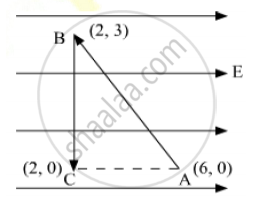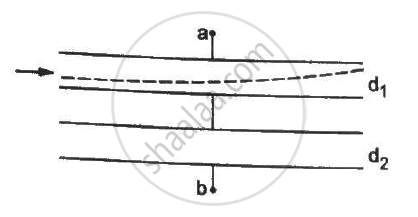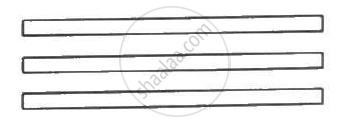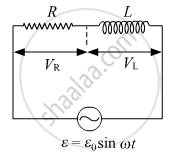Advertisements
Advertisements
Question
A charge of 20 µC is placed on the positive plate of an isolated parallel-plate capacitor of capacitance 10 µF. Calculate the potential difference developed between the plates.
Solution
Given :
Capacitance of the isolated capacitor = 10 µF
Charge on the positive plate = 20 µC
Effective charge on the capacitor = `(20-0)/2 = 10 "uC"`
The potential difference between the plates of the capacitor is given by `V = Q/C`
`therefore "Potential difference" = (10 "uC")/(10 "uF")`= `1 "V"`
APPEARS IN
RELATED QUESTIONS
Draw a labelled diagram of Van de Graaff generator. State its working principle to show how by introducing a small charged sphere into a larger sphere, a large amount of charge can be transferred to the outer sphere. State the use of this machine and also point out its limitations.
The potential difference applied across a given resistor is altered so that the heat produced per second increases by a factor of 9. By what factor does the applied potential difference change?
Explain the principle of a device that can build up high voltages of the order of a few million volts.
A test charge ‘q’ is moved without acceleration from A to C along the path from A to B and then from B to C in electric field E as shown in the figure. (i) Calculate the potential difference between A and C. (ii) At which point (of the two) is the electric potential more and why?

Both the capacitors shown in figure are made of square plates of edge a. The separations between the plates of the capacitors are d1 and d2 as shown in the figure. A potential difference V is applied between the points a and b. An electron is projected between the plates of the upper capacitor along the central line. With what minimum speed should the electron be projected so that it does not collide with any plate? Consider only the electric forces.

The capacitance between the adjacent plates shown in figure is 50 nF. A charge of 1⋅0 µC is placed on the middle plate. (a) What will be the charge on the outer surface of the upper plate? (b) Find the potential difference developed between the upper and the middle plates.

What will be the potential difference in the circuit when direct current is passed through the circuit?

In circuits, a difference in potential from one point to another is often called ______.
If a positive charge moves in the direction of the electric field ______.
The unit of potential difference as used in electrical circuits is ________.
Two metal pieces having a potential difference of 800 V are 0.02 m apart horizontally. A particle of mass 1.96 × 10–15 kg is suspended in equilibrium between the plates. If e is the elementary charge, then charge on the particle is ______.
Assertion: Electric potential and electric potential energy are different quantities.
Reason: For a system of positive test charge and point charge electric potential energy = electric potential.
On moving a charge of Q coulomb by X cm, W J of work is done, then the potential difference between the points is ______.
A and B are two points in an electric field. If the work done in carrying 4.0C of electric charge from A to B is 16.0 J, the potential difference between A and B is:
A bullet of mass of 2 g is having a charge of 2 µc. Through what potential difference must it be accelerated, starting from rest, to acquire a speed of 10 m/s.
If potential difference between the two ends of a metallic wire is doubled, drift speed of free electrons in the wire ______.
